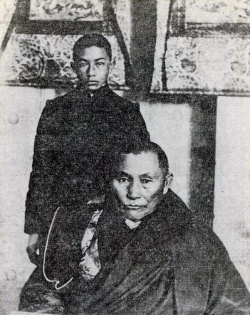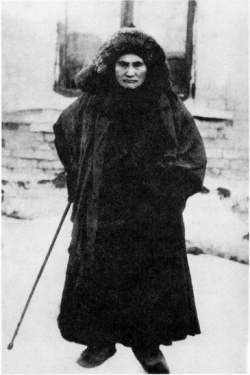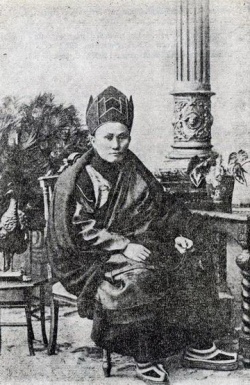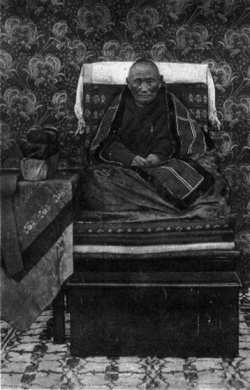The Shambhala missionary Agvan Dorjiev
The spread of the Shambhala myth and the Kalachakra Tantra in the West has a history of its own.
It does definitely not first begin with the expulsion of the lamas from Tibet (in 1959) and their diaspora across the whole world, but rather commences at the beginning of the twentieth century in Russia with the religious political activity of an ethnic Buriat by the name of Agvan Dorjiev.
Even in his youth, Agvan Dorjiev (1854–1938), who trained as a monk in Tibet, was already a very promising individual. For this reason he was as a young man entrusted with caring for the Thirteenth Dalai Lama. The duties of the Buriat included among other things the ritual cleansing of the body and bedroom of the god-king, which implies quite an intimate degree of contact.
Later he was to be at times the closest political adviser of His Holiness.
Dorjiev was convinced that the union of Tibet with Russia would provide the Highlands with an extremely favorable future, and was likewise able to convince the hierarch upon the Lion Throne of the merits of his political vision for a number of years. He thus advanced to the post of Tibetan envoy in St. Petersburg and at the Russian court. His work in the capital was extremely active and varied.
In 1898 he had his first audience with Tsar Nicholas II, which was supposed to be followed by others. The Russian government was opening up with greater tolerance towards the Asian minorities among whom the Buriats were also to be counted, and was attempting to integrate them more into the Empire whilst still respecting their religious and cultural autonomy, instead of missionizing them as they had still done at the outset of the 19th century.
Even as a boy, Nicholas II had been fascinated by Tibet and the “yellow pontiff” from Lhasa. The famous explorer, Nikolai Przhevalsky, introduced the 13-year-old Tsarevitch to the history and geopolitics of Central Asia. Przhevalsky described the Dalai Lama as a "powerful Oriental pope with dominion over some 250 million Asiatic souls” and believed that a Russian influence in Tibet would lead to control of the entire continent and that this must be the first goal of Tsarist foreign policy (Schimmelpennink, 1994, p. 16).
Prince Esper Esperovich Ukhtomsky, influential at court and deeply impressed by the Buddhist teachings, also dreamed of a greater Asian Empire under the leadership of the “White Tsars”.
Since the end of the 19th century Buddhism had become a real fashion among the Russian high society, comparable only to what is currently happening in Hollywood, where more and more stars profess to the doctrine of the Dalai Lama. It was considered stylish to appeal to Russia’s Asiatic inheritance and to invoke the Mongolian blood which flowed in the veins of every Russian with emotional phrases.
The poet, Vladimir Solovjov declaimed,
“Pan-Mongolism — this word: barbaric, yes! Yet a sweet sound”
The mysto-political influences upon the court of the Tsar of the naïve demonic village magician, Rasputin, are common knowledge. Yet the power-political intrigues of an intelligent Asian doctor by the name of Peter Badmajev ought to have been of far greater consequence.
Like Dorjiev, whom he knew well, he was a Buriat and originally a Buddhist, but he had then converted to Russian Orthodox. His change of faith was never really bought by those around him, who frequented him above all as a mighty shaman that was “supposed to be initiated into all the secrets of Asia” (Golowin, 1977, p. 219).
Badmajev was head of the most famous private hospital in St. Petersburg. There the cabinet lists for the respective members of government were put together under his direction.
R. Fülöp-Miller has vividly described the doctor’s power-political activities:
“In the course of time medicine and politics, ministerial appointments and 'lotus essences' became more and more mingled, and a fantastic political magic character arose, which emanated from Badmajev’s sanatorium and determined the fate of all Russia. The miracle-working doctor owed this influence especially to his successful medical-political treatment of the Tsar. ...
Badmajev’s mixtures, potions, and powders brewed from mysterious herbs from the steppes served not just to remedy patient’s metabolic disturbances; anyone who took these medicaments ensured himself an important office in the state at the same time”
(Fülöp-Miller, 1927, pp. 112, 148).
For this “wise and crafty Asian” too, the guiding idea was the establishment of an Asian empire with the “White Tsar” at its helm.
In this overheated pro-Asian climate, Dorjiev believed, probably somewhat rashly, that the Tsar had a genuine personal interest in being initiated into the secrets of Buddhism. The Buriat’s goal was to establish a mchod-yon relationship between Nicholas II and the god-king from Lhasa, that is, Russian state patronage of Lamaism.
Hence a trip to Russia by the Dalai Lama was prepared which, however, never eventuated.
Bolshevik Buddhism
One would think that Dorjiev had a compassionate heart for the tragic fate of the Tsarist family. At least, Nicholas II had supported him and the Thirteenth Dalai Lama had even declared the Russian heir to the throne to be a Bodhisattva because a number of attempts to give him a Christian baptism mysteriously failed.
At Dorjiev’s behest, pictures of the Romanovs adorned the Buddhist temple in St. Petersburg.
Hence, it is extremely surprising that the Buriat greeted the Russian October Revolution and the seizure of power by the Bolsheviks with great emotion. What stood behind this about-face, a change of attitude or understandable opportunism? More likely the former, then at the outset of the twenties Dorjiev, along with many famous Russian orientalists, was convinced that Communism and Buddhism were compatible.
He publicly proclaimed that the teaching of Shakyamuni was an “atheistic religion” and that it would be wrong to describe it as “unscientific”. Men in his immediate neighborhood even went so far as to celebrate the historical Buddha as the original founder of Communism and to glorify Lenin as an incarnation of the Enlightened One. There are reliable rumors that Dorjiev and Lenin had met.
Initially the Bolsheviks appreciated such currying of favor and made use of it to win Buddhist Russians over to their ideas. Already in 1919, the second year of the Revolution, an exhibition of Buddhist art was permitted and encouraged amidst extreme social turmoil. The teachings of Shakyamuni lived through a golden era, lectures about the Sutras were held, numerous Buddhist books were published, contacts were established with Mongolian and Tibetan scholars.
Even the ideas of pan-Mongolism were reawakened and people began to dream of blood-filled scenes. In the same year, in his famous poem of hate Die Skythen [The Scythians], Alexander Block prophesied the fall of Europe through the combined assault of the Russians and the Mongolians.
In it we can read that,
We shall see through the slits of our eyes
How the Huns fight over your flesh,
How your cities collapse
And your horses graze between the ruins.
Even the Soviet Union’s highest-ranking cultural official of the time, Anatoli Vassilievich Lunacharski, praised Asia as a pure source of inexhaustible reserves of strength:
“We need the Revolution to toss aside the power of the bourgeoisie and the power of rationality at the same time so as to regain the great power of elementary life, so as to dissolve the world in the real music of intense being. We respect and honor Asia as an area which until now draws its life energy from exactly these right sources and which is not poisoned by European reason”.
(Trotzkij, 1968, p. 55).
Yet the Buddhist, pan-Asian El Dorado of Leningrad transformed itself in 1929 into a hell, as the Stalinist secret service began with a campaign to eradicate all religious currents. Some years later Dorjiev was arrested as a counterrevolutionary and then put on trial for treason and terrorism.
On January 29, 1938 the “friend of the Dalai Lama” died in a prison hospital.
The Kalachakra temple in St. Petersburg
There is a simple reason for Dorjiev’s enthusiasm for Russia. He was convinced that the Kalachakra system and the Shambhala myth had their origins in the Empire of the Tsar and would return via it. In 1901 the Buriat had received initiations into the Time Tantra from the Ninth Panchen Lama which were supposed to have been of central significance for his future vision.
Ekai Kawaguchi, a Buddhist monk from Japan who visited Tibet at the turn of the last century, claims to have heard of a pamphlet in which Dorjiev wrote:
“Shambhala was Russia. The Emperor, moreover, was an incarnation of Tsongkhapa, and would sooner or later subdue the whole world and found a gigantic Buddhist empire”
(Snelling, 1993, p. 79).
Although it is not certain whether the lama really did write this document, it fits in with his religious-political ideas.
Additionally, the historians are agreed:
“In my opinion,” W.A. Unkrig writes, “the religiously-based purpose of Agvan Dorjiev was the foundation of a Lamaist-oriented kingdom of the Tibetans and Mongols as a theocracy under the Dalai Lama ... [and] under the protection of Tsarist Russia ... In addition, among the Lamaists there existed the religiously grounded hope for help from a ‘Messianic Kingdom’ in the North ... called 'Northern Shambhala’”
(quoted by Snelling, 1993, p. 79).
At the center of Dorjiev’s activities in Russia stood the construction of a three-dimensional mandala — the Buddhist temple in St. Petersburg. The shrine was dedicated to the Kalachakra deity. The Dalai Lama’s envoy succeeded in bringing together a respectable number of prominent Russians who approved of and supported the project. The architects came from the West.
A painter by the name of Nicholas Roerich, who later became a fanatic propagandist for Kalachakra doctrine, produced the designs for the stained-glass windows. Work commenced in 1909. In the central hall various main gods from the Tibetan pantheon were represented with statues and pictures, including among others Dorjiev’s wrathful initiation deity, Vajrabhairava.
Regarding the décor, it is perhaps also of interest that there was a swastika motif which the Bolsheviks knocked out during the Second World War. There was sufficient room for several lamas, who looked after the ritual life, to live on the grounds. Dorjiev had originally intended to triple the staffing and to construct not just a temple but also a whole monastery. This was prevented, however, by the intervention of the Russian Orthodox Church.
The inauguration took place in 1915, an important social event with numerous figures from public life and the official representatives of various Asian countries.
The Dalai Lama sent a powerful delegation,
“to represent the Buddhist Papacy and assist the Tibetan Envoy Dorjiev”
(Snelling, 1993, p. 159).
Nicholas II had already viewed the Kalachakra temple privately together with members of his family several days before the official occasion.
Officially, the shrine was declared to be a place for the needs of the Buriat and Kalmyk minorities in the capital. With regard to its occult functions it was undoubtedly a tantric mandala with which the Kalachakra system was to be transplanted into the West. Then, as we have already explained, from the lamas’ traditional point of view founding a temple is seen as an act of spiritual occupation of a territory.
The legends about the construction of first Buddhist monastery (Samye) on Tibetan soil show that it is a matter of a symbolic deed with which the victory of Buddhism over the native gods (or demons) is celebrated. Such sacred buildings as the Kalachakra temple in St. Petersburg are cosmograms which are — in their own way of seeing things — employed by the lamas as magic seals in order to spiritually subjugate countries and peoples.
It is in this sense that the Italian, Fosco Maraini, has also described the monasteries in his poetic travelogue about Tibet as,
“factories of a holy technology or laboratories of spiritual science”
(Maraini, 1952, p. 172).
In our opinion this approximates very closely the Lamaist self-concept. Perhaps it is also the reason why the Bolsheviks later housed an evolutionary technology laboratory in the confiscated Kalachakra shrine of St. Petersburg and performed genetic experiments before the eyes of the tantric terror gods.
The temple was first returned to the Buddhists in June 1991. In the same year, a few days before his own death, the English expert on Buddhism, John Snelling, completed his biography of the god-king’s Buriat envoy.
In it he poses the following possibility:
“Who knows then but what I call Dorjiev's Shambhala Project for a great Buddhist confederation stretching from Tibet to Siberia, but now with connections across to Western Europe and even internationally, may well become a very real possibility”
(Snelling, 1993, xii).
Here, Snelling can only mean the explosive spread of Tantric Buddhism across the whole world.
If we take account of the changes that time brings with it, then today the Kalachakra temple in Petersburg would be comparable with the Tibet House in New York. Both institutions function(ed) as semi-occult centers outwardly disguised as cultural institutions. In both instances the spread of the Kalachakra idea is/was central as well.
But there is also a much closer connection: Robert Alexander Farrar Thurman, the founder and current leader of the Tibet House, went to Dharamsala at the beginning of the sixties. There he was ordained by the Dalai Lama in person. Subsequently, the Kalmyk, Geshe Wangyal (1901-1983), was appointed to teach the American, who today proclaims that he shall experience the Buddhization of the USA in this lifetime.
Thurman thus received his tantric initiations from Wangyal.
This guru lineage establishes a direct connection to Agvan Dorjiev. Namely, that as a 19-year-old novice Lama Wangyal accompanied the Buriat to St. Petersburg and was initiated by him. Thus, Robert Thurman’s “line guru” is, via Wangyal, the old master Dorjiev. Dorjiev — Wangyal — Thurman form a chain of initiations.
From a tantric viewpoint the spirit of the master live on in the figure of the pupil. It can thus be assumed that as Dorjiev’s “successor” Thurman represents an emanation of the extremely aggressive protective deity, Vajrabhairava, who had incarnated himself in the Buriat. At any rate, Thurman has to be associated with Dorjiev’s global Shambhala utopia.
His close interconnection with the Kalachakra Tantra is additionally a result of his spending several months in Dharamsala under the supervision of Namgyal monks, who are specialized in the time doctrine.




